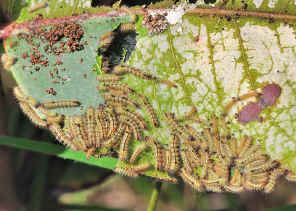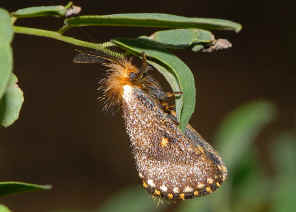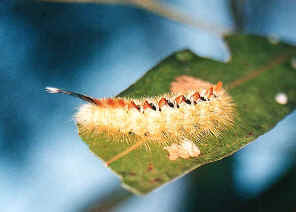|
| |
Family Notodontidae
- This page contains pictures and information about moths and
caterpillars in subfamily Thaumetopoeinae that we found in
the Brisbane area, Queensland, Australia.
-
 - Thaumetopoeinae Caterpillars
-
- Some reference put this subfamily as Family THAUMETOPOEIDAE.
Caterpillars in this subfamily have very dense hairs. They live together
in shelter of silk, i.e. their common name Bag-shelter Moth caterpillar.
They feed in group and sometime form processionary group to move to other
locations, i.e., their another common name Processionary
Caterpillars. The adult moths are similar
to the subfamily NOTODONTINAE but the eggs and caterpillars are very
different.
-
- Most
species of caterpillars in this subfamily can be seen feeding in group. Some
species caterpillars may be seen in procession, each following the silken
thread left by the one in front.
-
-

 
- Notodontin caterpillars feeding in
group
Caterpillar in Procession
A Notodontid male
-
- Pupation
usually occurs in mud cell in soil or in a tough silk cocoon under
bark.
-
- The
adult moths in this family are from medium to large size, with stout body.
The head, thorax and legs are often covered with long hair. The fore wing is
usually elongated-triangular form. The hind wing is round and much shorter
than the fore wing. They rest their fore wings folded roof-wise above the
abdomen, with fore wings cover entirely the hind wings. They are active at night.
-
-
- Bag-shelter Moth, Processionary
Caterpillar


 - Ochrogaster lunifer, Moth wingspan 40mm, caterpillar grows up to
70mm
- They
are common in Brisbane bushes. Caterpillars in large number can be found
resting/hiding on base of medium to large size wattle tree trunks. Caterpillars and moths are known
will cause irritation for human and other animals. Female moths lay eggs
mass covered by hairs and scales. The airborne
caterpillar hairs and moth scales will cause rashes and
also respiratory problems such as asthma. We recorded the annually cycle of
this species, details please found on this page.
-
-
- Brown Ring Epicoma Moth
 
 - Epicoma tristis, wingspan 30mm
- The moth's forewings are dark brown in colour,
with two rows of creamy spots along the wing edges. In the middle of its
forewings there is a dark ring with a yellow dot. Their Caterpillars are dark
grey with short hair, may
be seen in group or in procession. Their host plants include gum tree.
Please check this page for more
information.
-
-
- Yellow Spot Epicoma Moth

 - Epicoma protrahens, wingspan 30mm
- The moths are dark brown in colour with a white-yellow dot at the centre
of each fore wing. The caterpillars can be found on Bottlebrush feeding in
group. They are hairy with two black dots on first two abdominal segments. More information and pictures please check this page.
-
-
- Common Epicoma Moth


 - Epicoma melanosticta, male, wingspan 30mm
female
- This is the male Common Epicoma Moth. It has the white forewings each has
a dark brown patch with yellow spot centre on a brown diagonal line. Its
head and legs are hairy. Female is dark brown instead of white. Check this page
for more information.
-
-
- Black Spot Moth
-


- Epicoma melanospila, male, wingspan 30mm
- We found this moth outside our house. This moth came to our house
attracted by the window lights. Please check this page
for more infomation.
-
-
- White Notodontid Moth

 - Trichiocercus sp., female, wingspan 30mm
- This moth is creamy white in colour with a yellow abdomen. Head and legs
are covered with white hairs. Pictures were taken on Sep and Dec 2005.
Please visit this page for more pictures
and information.
-
-
- Sparshalli Moth

 - Trichiocercus sparshalli, length
40mm
- The caterpillar was found feeding on gum tree leaf during early summer. Few days later, it turned into a cacoon. Two to three weeks later,
a Tachinid
Fly came out instead of a moth from the cacoon. The Tachinid Fly came
out directly, not the fly larvae as in most other case. Only one fly came
out and it was dark grey in colour 10mm in body length, look exactly as
the Tachinid Flies that parasite on Crow
and Wanderer butterflies,
although a bit larger in size. Check this page
for more information.
-
- Reference:
- 1. NOTODONTIDAE of Australia
- Don Herbison-Evans & Stella Crossley, 2011.
- 2. Moths
of Australia - I. F. B. Common, Melbourne University Press,
1990, p417.
- 3. Moths
of Australia - Bernard D'Abrera, Lansdowne Press, Melbourne, 1974,
p70.
- 4. A
Guide to Australian Moths - Paul Zborowski, Ted Edwards, CSIRO
PUBLISHING, 2007, p173.
[ Up ] [ Notodontinae ] [ Thaumetopoeinae ]
Back to Top
| |
|


















